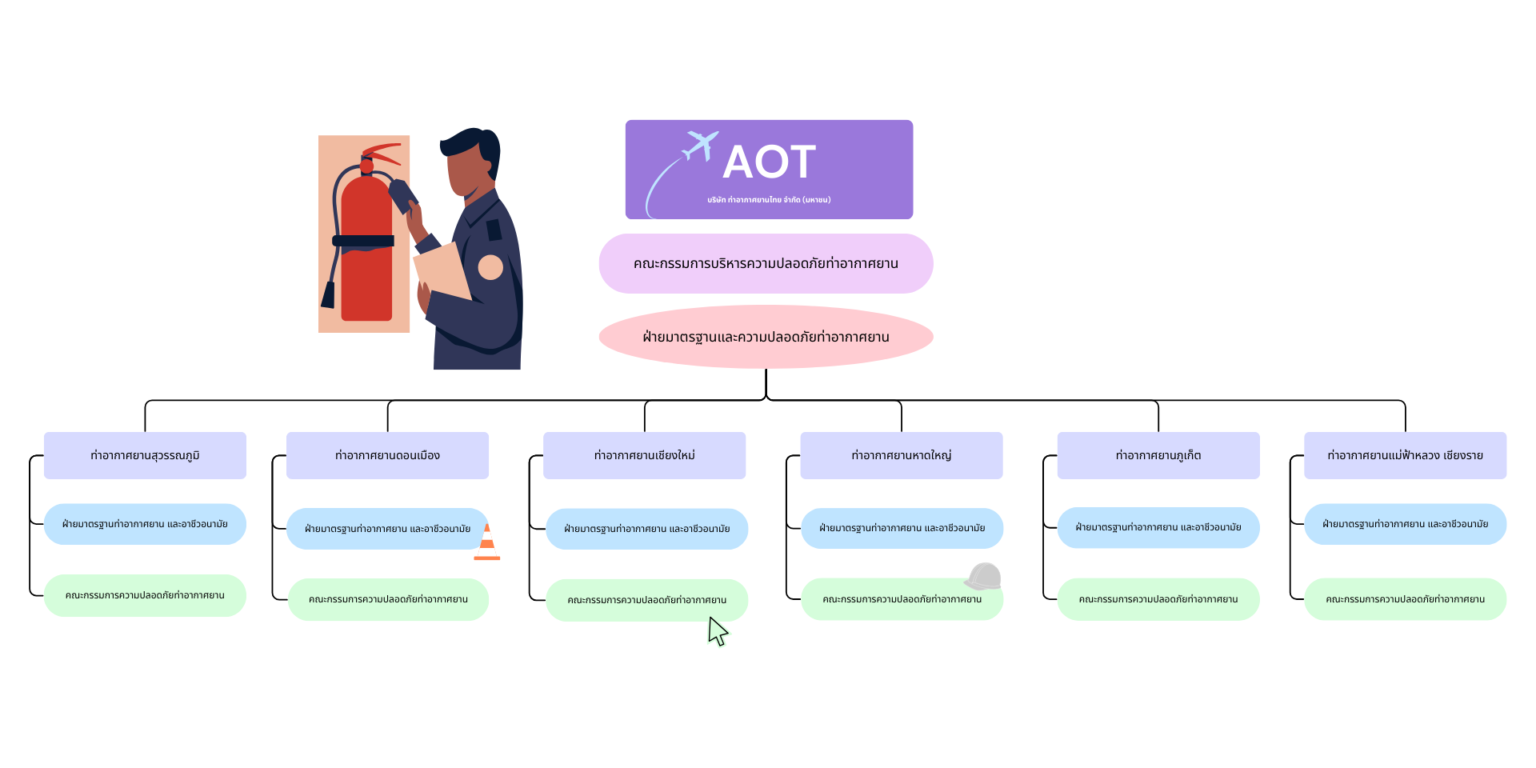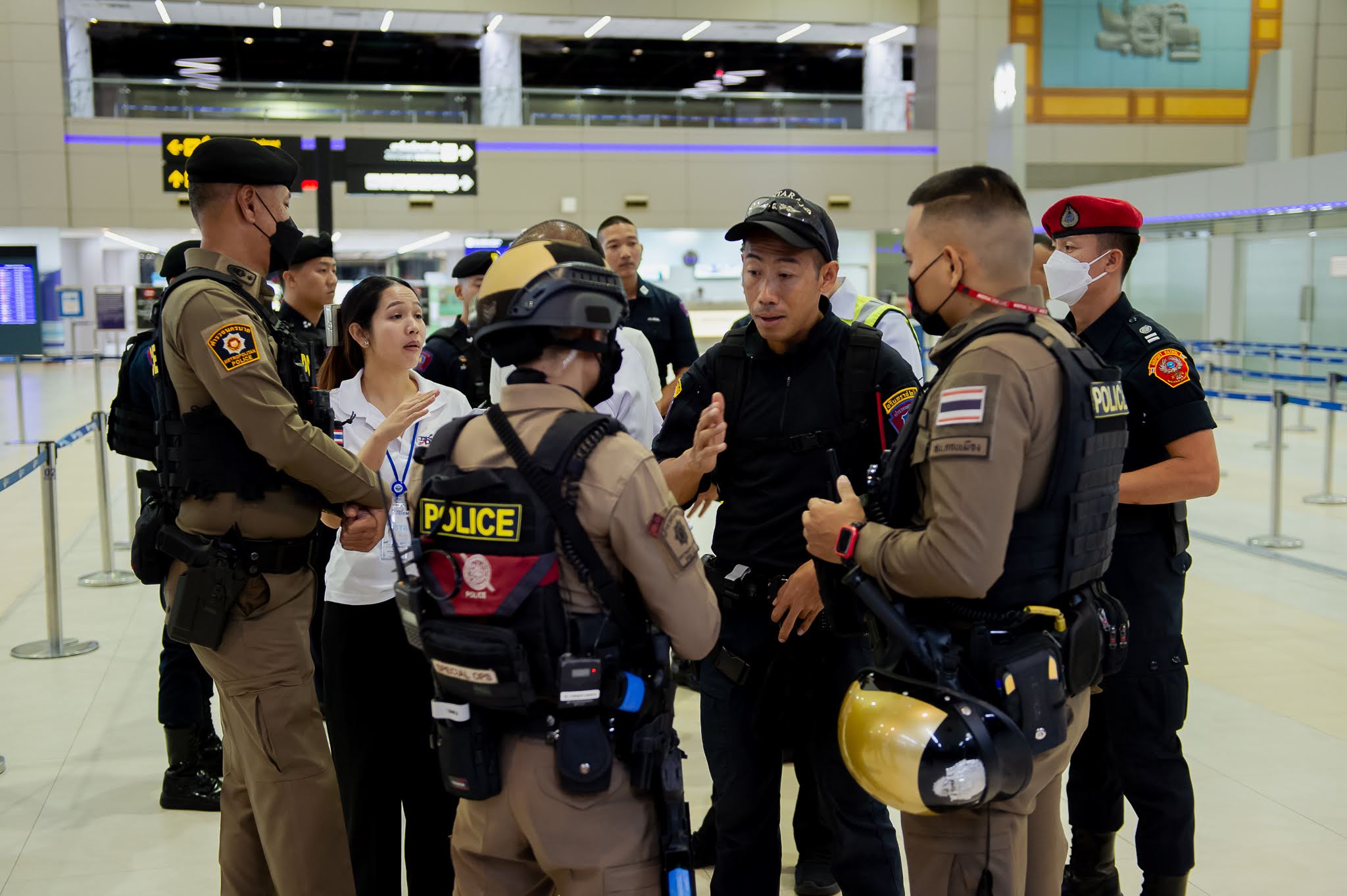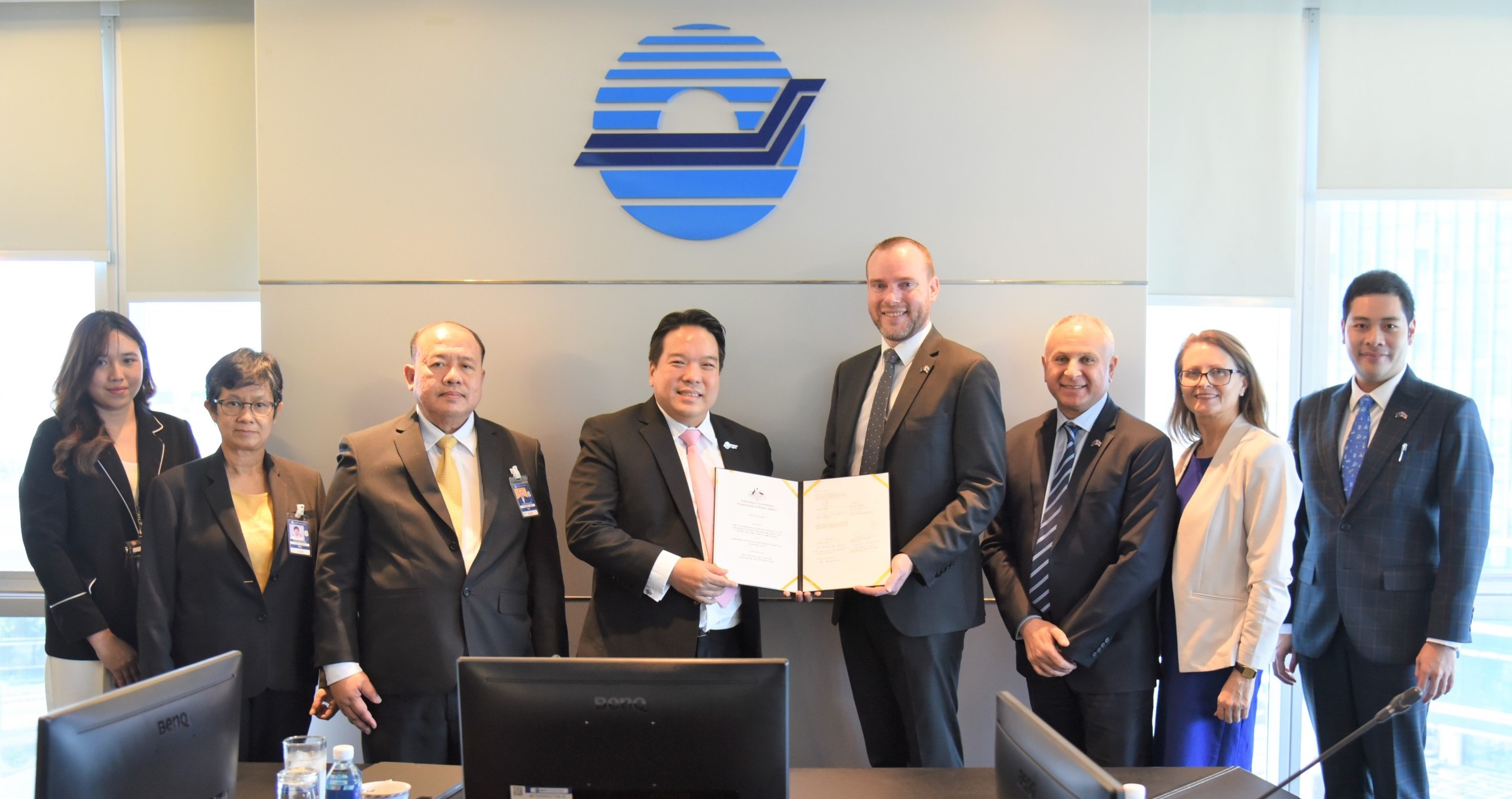Safety and Security
AOT is committed to providing high-quality services that prioritize safety while also generating sustainable revenue. This translation emphasizes AOT's dedication to excellence and its balanced approach to airport management.
Safety and security at airports are crucial issues that AOT is committed to addressing in accordance with state laws, regulations, and requirements, and in alignment with both national and international standards and practices, such as those of the Civil Aviation Authority of Thailand (CAAT) and the International Civil Aviation Organization (ICAO). This commitment extends to airport operations as well as to the surrounding communities and society, ensuring safety in airport services and security against unlawful activities or potential threats, thereby protecting human rights related to life and safety.
Having robust safety measures instills confidence in customers, staff, and business partners, leading to increased trust and reliance on AOT’s air transport services. However, stringent safety measures necessitate the application of advanced technologies and the development of employee capabilities to fully comply with safety standards. This also requires AOT to adapt its management systems to meet stricter measures effectively.
AOT is committed to continuously developing and enhancing safety standards to ensure that its operations achieve optimal safety performance in line with AOT’s strategies and values under the framework of sustainable development. Therefore, AOT adheres to its AOT Safety Policy and safety objectives, which align with the National Civil Aviation Safety Policy and the state's safety objectives, as well as the Occupational Health, Safety, and Workplace Environment Policy.
See more detail
Aerodrome Safety Management and Supervision Structure

AOT Safety Management Committee
แต่งตั้งโดย คณะกรรมการ ทอท.
มีกรรมการผู้อำนวยการใหญ่ เป็นประธาน ซึ่งเป็นผู้รับผิดชอบสูงสุดด้านความปลอดภัยตามระบบการจัดการด้านนิรภัยขององค์กร (SMS)
ผู้อำนวยการฝ่ายมาตรฐานและความปลอดภัยท่าอากาศยานเป็นผู้จัดการด้านความปลอดภัยในระดับองค์กร (AOT Safety Manager) และเป็นเลขานุการ
อำนาจหน้าที่
- กำหนดนโยบายความปลอดภัยตาม SMS กำหนดแผนงาน วิธีปฏิบัติ รวมทั้งระดับความปลอดภัยที่ยอมรับได้ (Acceptable Level of Safety Performance : ALoSPs) สอดคล้องกับแผนนิรภัยในการบินพลเรือนแห่งชาติ รวมทั้งควบคุม กำกับดูแลและประเมินผลการดำเนินงานให้เป็นไปตามนโยบาย แผนงานและระดับความปลอดภัยที่ยอมรับได้ของ ทอท.ที่กำหนดไว้ รวมทั้งให้เป็นไปตามระเบียบ ทอท.กฎ ระเบียบ ข้อบังคับที่รัฐกำหนด และมาตรฐานสากล
- ให้ข้อเสนอแนะและแก้ไขปัญหาข้อขัดข้องต่าง ๆ ที่กระทบต่อความปลอดภัยในการดำเนินงานของสนามบิน
- ติดตามและเร่งรัดการดำเนินงานแก้ไขข้อบกพร่องของสนามบินเพื่อให้ได้รับและรักษาใบรับรองการดำเนินงานสนามบินสาธารณะ (Public Aerodrome Operating Certificate)
- จัดประชุมเป็นประจำอย่างน้อยทุก 3 เดือน หรือตามที่กรรมการผู้อำนวยการใหญ่เห็นสมควร
- สนับสนุนและส่งเสริมการพัฒนาระบบการจัดการด้านนิรภัยของสนามบินอย่างต่อเนื่อง
- รายงานผลการดำเนินงานด้านความปลอดภัยของ ทอท. ที่มีนัยสำคัญหรือกระทบต่อการดำเนินงานด้านความปลอดภัยสนามบินของ ทอท.ให้คณะกรรมการ ทอท. ทราบ
- แต่งตั้งคณะกรรมการ คณะอนุกรรมการ และคณะทำงาน เพื่อสนับสนุนการดำเนินงานได้ตามความเหมาะสม
Aerodrome Safety Review Board
ได้รับการแต่งตั้งโดย ผู้อำนวยการท่าอากาศยาน
หัวหน้าหน่วยงานมาตรฐานท่าอากาศยานและอาชีวอนามัยเป็นผู้จัดการด้านความปลอดภัยของสนามบิน (Aerodrome Safety Manager) และเป็นเลขานุการประจำท่าอากาศยานที่ตนสังกัด
อำนาจหน้าที่
- จัดทำนโยบาย แผนงาน และโครงการความปลอดภัยของสนามบินเพื่อรองรับนโยบายความปลอดภัยของ ทอท.
- ดำเนินกิจกรรมด้านความปลอดภัยอย่างต่อเนื่อง รวมทั้งดำเนินกิจกรรมอื่นเพื่อเพิ่มระดับความปลอดภัยต่อกิจกรรมของสนามบินตามข้อเสนอของคณะกรรมการบริหารความปลอดภัยของสนามบิน
- แก้ไขปัญหาข้อขัดข้องต่าง ๆ ที่ทำให้เกิดความไม่ปลอดภัยของสนามบินกรณีที่เป็นเรื่องนอกเหนือจากอำนาจหน้าที่ของคณะกรรมการความปลอดภัย ให้เสนอกรรมการบริหารความปลอดภัยสนามบินของ ทอท.พิจารณา
- จัดประชุมเป็นประจำอย่างน้อยทุก 3 เดือน
- ติดตาม ประเมินผลการปฏิบัติ โดยการสำรวจความปลอดภัยด้านการบินเป็นปนะจำทุกเดือน และนำผลการสำรวจเข้าที่ประชุมคณะกรรมการความปลอดภัยสนามบินและคณะกรรมการบริหารความปลอดภัยของสนามบินของ ทอท.ตามลำดับ
- แต่งตั้ง คณะอนุกรรมการ และคณะทำงานเพื่อสนับสนุนการดำเนินงานได้ตามความเหมาะสม
และในปีงบประมาณ 2566 กอญ. ในฐานะประธานกรรมการบริหารความปลอดภัยของ ทอท.ได้แต่งตั้งคณะทำงานเตรียมความพร้อมและติดตามการดำเนินการเพื่อรองรับการตรวจสอบ USOP-CMA จาก ICAO ตามนโยบายของกระทรวงคมนาคม เพื่อกำกับ ติดตามการดำเนินการตามแผนปฏิบัติการด้านความปลอดภัย ประกอบด้วย แผนเตรียมความพร้อมในการรองรับการตรวจติดตาม (Surveillance) จาก กพท. และแผนพัฒนาความปลอดภัยสนามบินของ ทอท. เพื่อเพิ่มค่า Effective Implementation (EI) Score ซึ่งถูกกำหนดเป็นตัวชี้วัดตามแผนวิสาหกิจ ทอท. ฉบับปี 2566 - 2570
Management Approaches
Safety management
AOT emphasizes the implementation of robust airport safety management in accordance with its rules, regulations, and standards, as well as in alignment with ICAO’s standards and recommended practices, such as the Safety Management System (SMS) and the State Safety Programme (SSP). This continuous improvement aims to enhance safety levels consistently. Examples of safety management activities include:
- Implementing AOT’s safety policy and objectives, which align with the National Civil Aviation Safety Policy and the state's safety objectives.
- Supervising, inspecting, and providing guidance on airport physical standards, air navigation facilities, visual navigation aids, the Public Aerodrome Manager Certificate, and the Aerodrome Manual for the six airports under AOT’s responsibility.
- Executing the safety plans of the Airport Standards and Safety Division.
- Conducting organizational safety assurance audits.
- Developing safety personnel to comply with the Airport Safety Management System.
Safety Management System (SMS)
AOT complies with state laws under the supervision of the Civil Aviation Authority of Thailand (CAAT), ensuring that all six AOT airports adhere to the Airport Safety Management System. This compliance aligns with the Civil Aviation Board Regulation No. 82 on the Airport Safety Management System, the National Civil Aviation Safety Plan, and the 2014 Civil Aviation Department regulations on airport operational processes related to the Safety Management System. The following measures are implemented:
- Establish an Airport Safety Management System Manual and an Internal Audit Manual for Airport Standards and Safety.
- Define Safety Policy and Safety Objectives.
- Set up the Organization Structure and Responsibilities.
- Manage documentation by collecting and maintaining up-to-date safety data and safety information, and ensure the sharing and protection of safety data.
- Identify safety hazards and manage safety risks by reporting safety information in various formats within specified timeframes, analyzing safety incidents, following up on safety events, and assessing safety risks.
- Provide Safety Assurance to ensure that safety operations are effective as specified.
- Promote Safety.
- Develop and conduct exercises for the Aerodrome Emergency Plan.
Airport Emergency Response Plan
AOT ensures airport readiness for emergencies that may occur within or near the airport by conducting full-scale and partial emergency exercises. These exercises aim to mitigate the impact of emergencies, particularly to save lives and maintain airport operations. AOT coordinates with all relevant internal and external agencies to handle and respond to emergencies in accordance with CAAT Regulation No. 37 on airport standards. In 2023, all six AOT airports conducted emergency exercises on aircraft accidents and collaborated with internal and external agencies to practice aircraft recovery procedures as per state requirements and ICAO standards.
See more detail
Security Management
AOT is committed to reducing deficiencies identified during security audits and tests to enhance aviation security at its airports. This also aims to improve the efficiency of state oversight of airport security operations, affecting the International Civil Aviation Organization's (ICAO) assessment under the Universal Security Audit Programme – Continuous Monitoring Approach (USAP-CMA). AOT undertakes the following actions:
- Establish or review policies, practices, and additional management processes for airport security.
- Conduct activities for the development of security personnel.
- Implement security quality control activities, including regular audits by the Civil Aviation Authority of Thailand and internal security audits.
- Develop emergency security measures by creating the "Security Risk Assessment Manual and Guidelines for Action Based on Threat Levels to Civil Aviation at AOT" and drafting airport emergency response plans in compliance with state regulations and ICAO standards. These plans are regularly exercised within specified timeframes, with each drill considering current threat information to create realistic scenarios. The 2023 annual civil aviation security exercise was conducted as follows:
Security risk assessment manual and guidelines according to the level of threats to civil aviation of AOT.
AOT has prepared a Security Risk Assessment Manual and Guidelines for Civil Aviation Threat Levels, which aligns with the Civil Aviation Security Risk Assessment Manual of Thailand prepared by the Civil Aviation Authority of Thailand. The objective is to provide airports under AOT’s responsibility with guidelines for identifying threats and assessing security risks at the airport level. It also serves as a guideline for determining measures to mitigate risks and reduce impacts in accordance with the threat levels of each airport, as recommended by the Civil Aviation Authority of Thailand. AOT continuously reviews and updates the manual to ensure it is current and relevant to the situation and threats to civil aviation.
Safety and Security Measures
Airport Security Plan (ASP)
All of AOT 6 airports have prepared their airport security programme (ASP) in compliance with the National Civil Aviation Security Programme (NCASP), issued by the Civil Aviation Authority of Thailand, and the standards of the International Civil Aviation Organization (ICAO) as guidelines and framework for security operation at each airport. Security measures stipulated in the Airport Security Programme of each airport are preventive and proactive plans, which would be reviewed and adjusted continuously to stay up to date.
Airport Contingency Plan (ACP)
All of AOT 6 airports have prepared their Airport Contingency Plans (ACP) to determine relevant units, scope of responsibilities and procedures, as well as coordination methods among airport operators, air navigators, air traffic controllers, local law enforcers, the Civil Aviation Authority of Thailand and other relevant parties that are responsible to respond to acts of unlawful interference to civil aviation. This is to adhere to requirements in the National Civil Aviation Security Programme (NCASP), relevant standards, rules and regulations in order to ensure an effective response to unlawful interference actions.
Information Systems Development on Airport Security
(e-Security)
AOT has developed an airport security information system (e-Security) to collect personal history, preventive security operations, issuance of personal security pass, collection of security statistics, quality control of security audits and security training courses that educate strict and secure operation procedures, which lead to enhancement of work efficiency of AOT employees and highest security for service users, workers, and other related individuals at the airport.
The system has been further developed and solved the work process problem of the existing system to become up to date. Users can save data via Web Application or Native Mobile Application. Moreover, the system will update the personal data and offenders’ records, as well as the background of persons and vehicles entering the airport areas. E-Security system will serve both centralized usage (access information of all airports) and decentralized usage (access information in the separation of each airport), and have an authentication system where an individual user has his/her own user name and password to access the system according to his/her rights. These would be able to monitor the operation procedures of those involved in the system and external incidents that may occur. It makes AOT's airports safer and builds more confidence in passengers or airlines. The system is available for use at the beginning of 2022.
In addition, AOT is currently in the process of adopting advanced and efficient information and communication technologies such as biometric identification system via fingerprint and Access Control System (ACS), etc. for screening and inspecting individuals in order to enhance safety and security of passengers and operators at the airport. This plan is scheduled to be completed at all airports, including AOT’s Head office within the year 2023.
Safety Management Review
Review of safety management and security measures. Establish or review policies, practices, and additional management processes in airport security every 3 months to discuss various management issues on the agenda of safety and security measures meetings.
Management Evaluation
AOT and the Government apply the safety standard audit, in both physical and operational aspects, as the mechanism to supervise aerodrome safety standard in compliance with state’s regulations and international standards to assure of airport users’ safety. The auditing process is divided into 3 levels as follows:
- At Airport Level (Self Audit)
The Aerodrome Standards and Occupational Health Division of each airport is responsible for auditing safety standards at the airport level. - At Corporate Level (Internal Audit)
AOT Aerodrome Standards and Safety Department is responsible for internal auditing on safety standards of every airport at least once a year, supervising safety of all airports in general, monitoring risk statistics report, defining level of risk, and searching for reducing/controlling methods to be as Low as Reasonably Practicable (ALARP) level. These implementations will be proceeded through AOT’s Aerodrome Safety Management Committee to ensure that safety deficiencies shall be rectified and safety performance shall be measured according to safety indicators and safety targets as defined by AOT. - At State Level (State Audit)
The Civil Aviation Authority of Thailand (CAAT), Ministry of Transport, is responsible for auditing and supervising safety standards of airports under AOT’s supervision on an annual basis, as well as providing opinions and suggestions to AOT on safety matters. However, CAAT is also audited and monitored by the International Civil Aviation Organization (ICAO) under the Universal Safety Oversight Audit Program (USOAP).
Aviation Security Quality Control Programme
AOT has prepared the Aviation Security Quality Control Programme to be used as a standard for security quality control at the airports under the responsibility of AOT. The programme involves quality control activities consisting of Security Audit, Security Inspection, Security Test, and Security Survey based on inspection principles and guidelines of the National Civil Aviation Security Quality Control Programme (NCASQCP). In addition, AOT's Internal Auditors were trained in courses according to international standards.
Safety and Security Culture
AOT recognizes the importance of developing and enhancing the knowledge and skills of its personnel to strengthen a modern management system. This is achieved by offering both theoretical and practical safety training courses, conducting airport emergency drills, and consistently fostering a safety and security culture within the organization. The details are as follows:
- Creating awareness and understanding of safety and security procedures, including operational frameworks and manuals, for continuous development and improvement.
- Raising awareness among personnel to prevent and mitigate potential risks related to airport safety, including reporting any risks or incidents that may arise and cause various impacts.
- Developing e-Safety and e-Security information systems for airports to integrate with safety and security operations and management.
- Utilizing data collected through digital technology for analysis and management to enhance AOT’s safety and security management efficiently.
- Gathering feedback through various AOT channels and applying lessons learned from incidents to develop and improve operational practices.
Promoting a Culture of Safety and Security
AOT has a safety operations structure in collaboration with external agencies, such as organizational and airport level safety committees consisting of representatives from various departments both inside and outside the airport. By holding a meeting to discuss according to the specified circle. to exchange information Identify risks Evaluate and create measures to reduce risks that cause mutual insecurity. Including promoting shared safety by conveying and communicating to create a safety culture, such as the Safety Day project to promote a culture of safety and security in 2023.

Emergency and Contingency Plan Drills
All airports under AOT's responsibility have established Airport Contingency Plans in accordance with government regulations and aligned with the standards of the International Civil Aviation Organization (ICAO). Regular drills are conducted as per the scheduled intervals. During each drill, current threat information is considered to create realistic scenarios, selecting high-risk threats for practice. This ensures the ability to effectively respond, control, direct, and restore normal operations quickly, maintaining business continuity.

Collaborative training project between AOT and Cyber and Infrastructure Security Group (CISG)
CISG delivers laptops installed with CARSA X-ray Tutor Software to AOT, totaling 10 machines, under the Enhancing AOT Security Screener Capability project. The objective is to use them for training new staff and for refresher training to enhance their ability to detect prohibited items for individuals performing image analysis. This includes increasing the opportunity for image analysts to practice and improve their skills in inspecting registered (Hold Baggage) and non-registered (Cabin Baggage) items.
The Operational Cyber Security in Aviation workshop aims to provide personnel responsible for managing computer systems and information technology at AOT with in-depth knowledge and skills to assess and mitigate risks, as well as prevent potential cyber-attacks on systems, infrastructure, and information.
The Aviation Cyber Security practical seminar aims to increase awareness of security related to preventing cyber attacks. It also enhances knowledge about cyber threats (Cyber Attack) and cybercrime, including various forms of cyber attacks and vulnerabilities that may make an organization a target. The focus is on risk assessment in operations and finding ways to mitigate potential risks.
Last Updated: May, 5 2024
